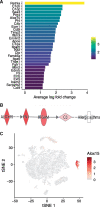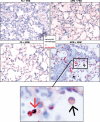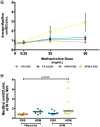Single-Cell RNA Sequencing Reveals a Unique Monocyte Population in Bronchoalveolar Lavage Cells of Mice Challenged With Afghanistan Particulate Matter and Allergen
- PMID: 34051097
- PMCID: PMC8331170
- DOI: 10.1093/toxsci/kfab065
Single-Cell RNA Sequencing Reveals a Unique Monocyte Population in Bronchoalveolar Lavage Cells of Mice Challenged With Afghanistan Particulate Matter and Allergen
Abstract
Upon returning from deployment to Afghanistan, a substantial number of U.S. military personnel report deployment-related lung disease (DRLD) symptoms, including those consistent with an asthma-like airways disease. DRLD is thought to be caused by prolonged inhalation of toxic desert particulate matter, which can persist in the postdeployment setting such as exposure to common household allergens. The goal of this study was to define the transcriptomic responses of lung leukocytes of mice exposed to Afghanistan desert particulate matter (APM) and house dust mite (HDM). C57BL/6 mice (n = 15/group) were exposed to filtered air or aerosolized APM for 12 days, followed by intranasal PBS or HDM allergen challenges for 24 h. Bronchoalveolar lavage (BAL) cells were collected for single-cell RNA sequencing (scRNAseq), and assessment of inflammation and airway hyper-responsiveness. Unsupervised clustering of BAL cell scRNAseq data revealed a unique monocyte population induced only by both APM and allergen treatments. This population of monocytes is characterized by the expression of genes involved in allergic asthma, including Alox15. We validated Alox15 expression in monocytes via immunostaining of lung tissue. APM pre-exposure, followed by the HDM challenge, led to significantly increased total respiratory system resistance compared with filtered air controls. Using this mouse model to mimic DRLD, we demonstrated that inhalation of airborne PM during deployment may prime airways to be more responsive to allergen exposure after returning home, which may be linked to dysregulated immune responses such as induction of a unique lung monocyte population.
Keywords: ALOX15; allergic asthma; particulate matter; single-cell RNA sequencing.
© The Author(s) 2021. Published by Oxford University Press on behalf of the Society of Toxicology.All rights reserved. For permissions, please e-mail: journals.permissions@oup.com.
Figures







References
-
- Adel S., Karst F., Gonzalez-Lafont A., Pekarova M., Saura P., Masgrau L., Lluch J. M., Stehling S., Horn T., Kuhn H., et al. (2016). Evolutionary alteration of ALOX15 specificity optimizes the biosynthesis of antiinflammatory and proresolving lipoxins. Proc. Natl. Acad. Sci. U S A 113, E4266–E4275. - PMC - PubMed
-
- Andersson C. K., Claesson H. E., Rydell-Tormanen K., Swedmark S., Hallgren A., Erjefalt J. S. (2008). Mice lacking 12/15-lipoxygenase have attenuated airway allergic inflammation and remodeling. Am. J. Respir. Cell Mol. Biol. 39, 648–656. - PubMed
Publication types
MeSH terms
Substances
Grants and funding
LinkOut - more resources
Full Text Sources
Other Literature Sources
Molecular Biology Databases

